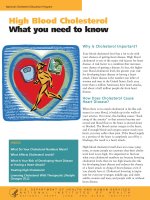REMEMBERING WHAT YOU HAVE TO SAY? pot
Bạn đang xem bản rút gọn của tài liệu. Xem và tải ngay bản đầy đủ của tài liệu tại đây (203.96 KB, 34 trang )
TRƯỜNG ĐẠI HỌC NÔNG LÂM
THÀNH PHỐ HỒ CHÍ MINH
PRESENTATIONAL SKILLS
By
Vo Van Viet
LECTURE 2
REMEMBERING
WHAT YOU HAVE TO SAY?
Techniques for Remembering
Speech Material
The four most common
methods of remembering
speech and presentation
material are the following:
1. Memorizing
2. Reading from complete text
3. Using notes
4. Using visual aids
1. Memorizing
•
Perhaps the most difficult method
of the four methods, memorizing is
the technique many novice
speakers start off with, because
they are under the impression that
this is how all speeches are
prepared and delivered
•
The most polished speakers forget
their words halfway through
1. Memorizing (cont.)
•
I actually do not recommend
memorizing your speech.
•
Although the outcome can be
very effective, memorizing a
speech word for word and
then delivering it requires a lot
of preparation and practice
1. Memorizing (cont.)
•
First you must write or type out the
speech. Since most people do not
write the way they speak, this
creates and immediate problem.
–
For example, the use of gestures and
proper voice inflection in conjunction with
a memorized speech tends to be very flat
and unengaging.
–
Even if you are successful in using
gestures and a lively tone of voice, it's
entirely possible that you will forget
portions of your speech.
1. Memorizing (cont.)
•
With memorizing, mental blocks
are inevitable, and it is not a
question of "Will you forget?" but
"when you will forget?" Can you
memorize a speech? Yes. Should
you memorize a speech? I don't
recommend it. Speakers who rely
strictly on memorization are
setting themselves up for failure.
2. Reading from Complete Text
•
Most people dislike listening
to someone read a speech or
presentation, even if the
speaker makes a concerted
effort to maintain eye contact
with the audience.
2. Reading from Complete Text
(cont.)
•
Your audience is just likely to
end up saying,"If all he is
going to do was read his
speech, I could have read it
myself."
2. Reading from Complete Text
(cont.)
Following are the reasons I believe
people read speeches poorly:
•
The speaker loses normal voice
inflection because they lose touch
with the ideas behind the words.
•
The test being read is usually not
written in the manner and style of
spoken language. Too often speakers
write their speeches in "business
language" that is often very difficult to
read, much less listen to.
2. Reading from Complete Text
(cont.)
•
The speaker achieves little or no eye
contact. Any eye contact is with the
manuscript and not with the audience.
To maintain eye contact with the
audience and read text effectively takes
a lot of practice. You have to take in
several lines at a time and keep your
place. You are very likely to find
yourself losing your place every time
you look up to speak to the audience.
2. Reading from Complete Text
(cont.)
If reading is absolutely
necessary, here are some
suggestions to make your
reading sound more
professional:
2. Reading from Complete Text
(cont.)
•
Pay attention to your voice inflection.
To sound natural you need to rehearse
often, checking yourself for pauses. Ask
yourself if your written words sound the
way you would speak them. Tape
yourself and listen to your own voice.
Note where changes need to be made
with your voice inflection. Try not to
over inflect your voice or it will become
distracting to your audience.
2. Reading from Complete Text
(cont.)
•
Say the words out loud. As
you're practicing your speech, read
it out loud several times so you can
hear your tone and voice
inflections. The more you practice
reading, the more comfortable and
familiar with the words you
become. Using this approach
makes it easier to read your speech
and for the audience to listen to it.
2. Reading from Complete Text
(cont.)
•
Annotate your text. Give yourself
cues for emphasis in the margin of your
text. For example, numbers are the
easiest target words to say slowly and
with emphasis. You want to emphasize
each syllable of any number word. For
example, if you have the word "fifty" in
your speech, and it appears as 50, make
it a note in the margin so you say "fif-
ty" when you get it.
2. Reading from Complete Text
(cont.)
•
Use gestures. Many speakers are
so busy making sure they read the
text correctly, they fail to
communicate effectively with their
body. One strategy is to double space
your typed text. This leaves room for
you to jot down notes and cues about
which words to emphasize and
gestures to accompany certain
sentences, points, or key messages
2. Reading from Complete Text
(cont.)
•
Videotape yourself I still videotape
my speeches and presentations,
especially those I deliver for the first
time. I recommend you sit down with
pen and paper in your hand and take
notes as you watch your video.
Watch the video several times, each
time taking notes on different things
you see. Here is the process I use to
review my videotapes:
2. Reading from Complete Text
(cont.)
•
Review 1. - Watch the entire tape
(alone) without being too critical.
Watch the tape as an audience might
for the first time.
•
Review 2. - Darken the picture or
turn you back to the television so
you cannot see yourself but you can
hear your voice. Record on your
notepad things you liked and disliked
about your voice; for example. listen
to how you phrase your words and
the inflection in your voice.
2. Reading from Complete Text
(cont.)
•
Review 3. - Turn down the sound and
just watch yourself.
•
Review 4. - Watch the tape again with
the volume turned up and take more
notes. See if there are any areas you
missed during earlier reviews.
•
Review 5. _ Have someone else watch
the tape who will be honest and
objective, such as your spouse, child,
friend, and so on
Using Notes
•
Notes capture the major sections and
main points of each section. I
recommend using either note or index
cards.
•
This is the most common way to
remember speech material.
•
Using notes has more advantages
than reading because you use your
normal voice inflection and make
more effective eye contact with your
audience.
Using Notes (cont.)
Here are suggestions to consider if
you decide to use notes:
* Keep it brief. - Don't write out
whole paragraphs of text. Put only
a few key words or phrases on
each card, just enough to jog your
memory. Also put only one or two
ideas on each card, and print large
and neatly so your notes are easy
to read.
Using Notes (cont.)
•
Remember to number your
note cards! - Just in case you
drop them.
•
Include quotes, statistics,
and lists. - Don't include
whole paragraphs of text.
Using Notes (cont.)
•
Leave your notes on the lectern
or table as you're speaking and
move away occasionally. - Don't
be afraid to move away from your
notes and get out of your comfort
zone. Too many speakers use the
lectern to hide behind, and this
restricts the use of your body. If
the notes are in your hand, you
won't gesture as often.
Using Notes (cont.)
•
Practice using your note
cards. - Practice helps you
analyze your note cards. For
example, if you find yourself
reading from your note cards
too much, reduce the amount
of written text on your cards.
Using Notes (cont.)
•
In some cases it's best to
draw a sketch or diagram on
your note cards. Sometimes
a simple drawing is all you
need to jog your memory.









